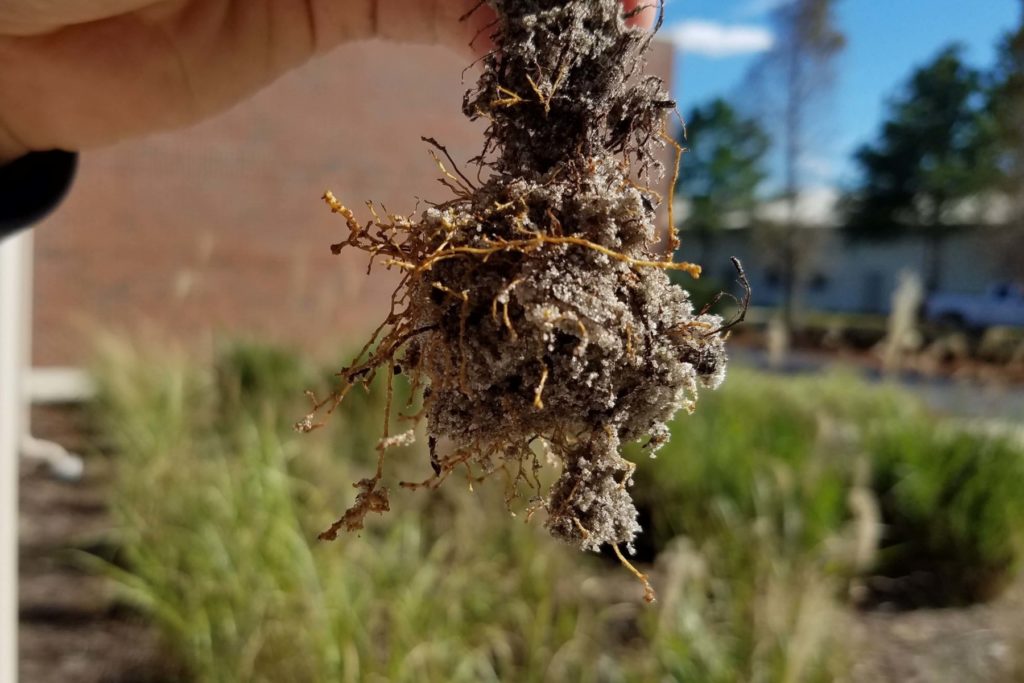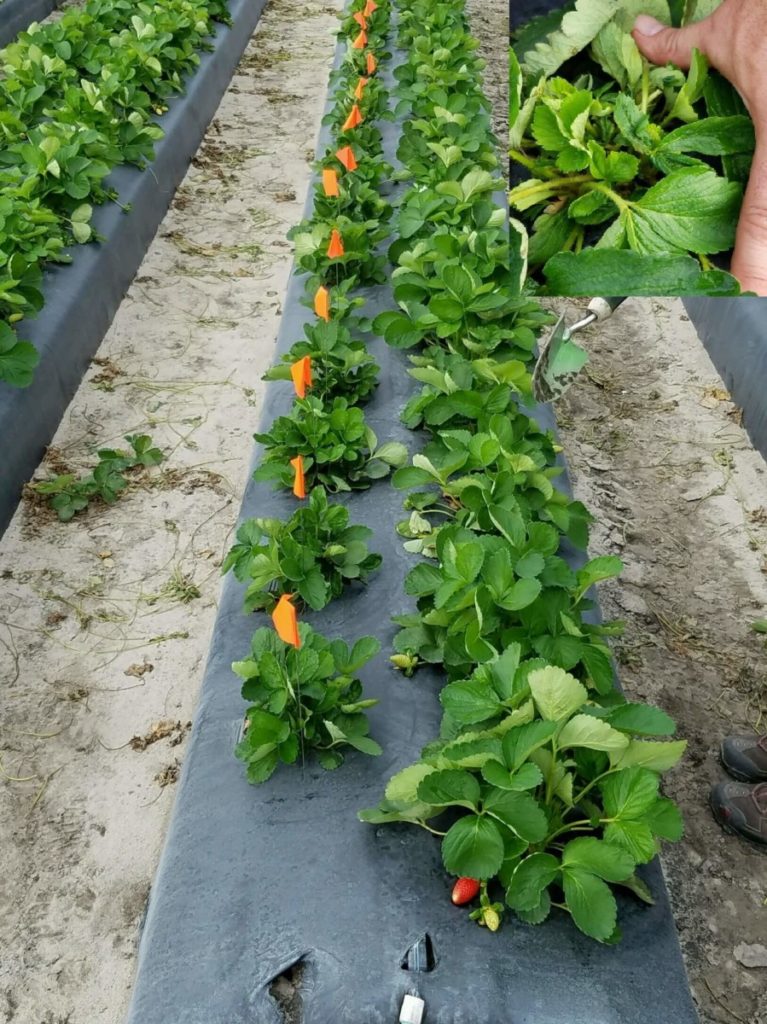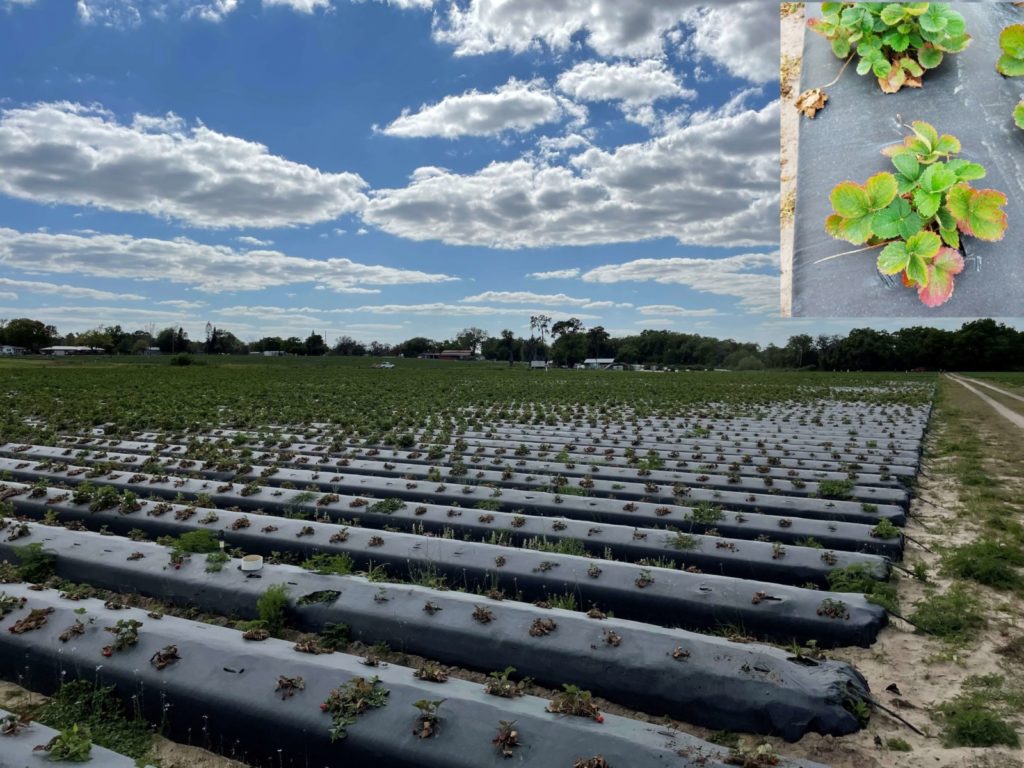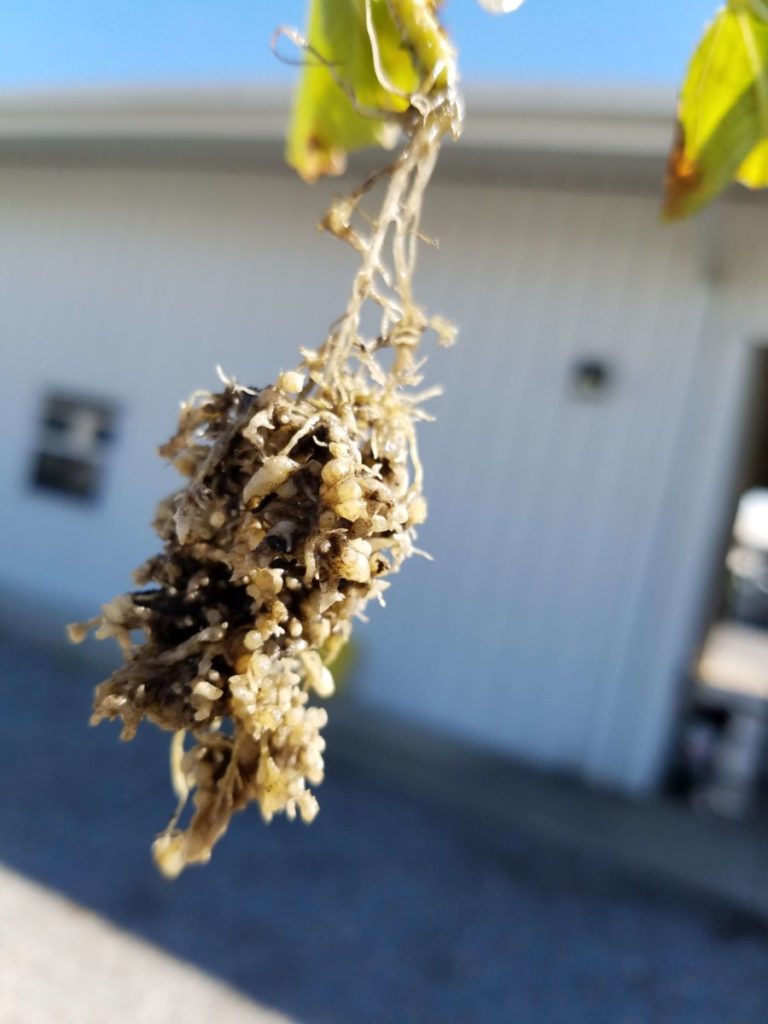By Johan Desaeger, Assistant Professor of Entomology and Nematology, University of Florida, Institute of Food and Agricultural Services
Nematodes are one of the most underestimated agricultural pests,and this is no exception in strawberries. Particularly damaging and difficult to manage is the sting nematode (Belonolaimus longicaudatus, literally ‘long-tailed arrow-like plague’). Sting nematodes are native to the sandy coastal plains of the southeastern U.S.and are very widespread in Florida strawberry fields. They are one of the largest plant-parasitic nematodes, measuring almost 1/10 inch long. They have a very long stylet, a hypodermic-like needle which is used to feed on strawberry roots, killing the root meristem and halting root growth. Lateral roots will develop, but the nematode will migrate to these lateral roots and damage them as well. This causes an abbreviated and stubby-looking root system (Photo 1). Sting nematodes have a strong preference for sandy soils and rarely cause problems in heavier and more organic soils.

Photo: J. Desaeger, University of Florida.

Photo: J. Desaeger, University of Florida.
Other nematodes of importance are the northern root-knot nematode (Meloidogyne hapla, https://edis.ifas.ufl.edu/in1224), which causes knots or galls on the roots, and the northern lesion nematode (Pratylenchus penetrans), which causes dark lesions on the roots. As the common name implies, these nematodes are found mostly in northern regions and are more adapted to cooler temperatures. Both nematodes are endoparastic, which means they live inside the roots, and therefore can be spread via strawberry transplants. In Florida,they probably have been introduced with infected transplants from the northern U. S. and Canada, where most of Florida’s strawberry plants are grown. Another nematode that can infect strawberries and can be spread with transplants are foliar or bud nematodes (Aphelenchoides besseyi, A. ritzemabosi, and A. fragariae). Foliar nematodes (A. besseyi, https://edis.ifas.ufl.edu/in1184) were found causing considerable damage in several strawberry farms in Florida in 2016-17. Although they have been reported from Florida since the early 1900’s, the most recent infection likely originated in an out-of-state nursery. Foliar nematode symptoms on strawberry include deformation of buds, leaves, and flowers; undersized leaves with crinkled edges; tight crowns; reddened and stunted petioles; and few flowers and fruits (Photo 2). Those symptoms can be confused with mite or insect damage, which is why suspected plants are rarely diagnosed for nematode presence.
Both sting and root-knot nematodes can cause stunting of plants and reddening and yellowing of foliage (Photo 3). Sting nematodes tend to cause more damage earlier in the season, as soon as plants start producing fruit, whereas root-knot nematode damage more typically occurs towards the end of the season when soils are cooler. Root-knot nematodes can cause late season collapse of strawberries, but yield loss at this time has less of an economic impact, unlike the early season damage caused by sting nematodes. However, yield loss can be severe when vegetable double-crops, such as melons, squash, or pepper, are planted following the strawberry crop, which is a common practice in Florida (Photo 4). In this case, it is recommended to apply a nematicide to help protect the double crop.

Photo: J. Desaeger, University of Florida.

Photo: J. Desaeger, University of Florida.
The northern root-knot nematode is the only root-knot nematode species that causes damage to strawberries. Other more common root-knot nematode species in the southern US, like the southern root-knot (M. incognita), the Javanese root-knot (M. javanica), and the peanut root-knot (M. arenaria) nematode, can cause considerable damage to vegetables and other crops but they do not seem to infect strawberries.
Young strawberry plants are much more susceptible to nematode damage,and it is key to minimize nematode damage right from the get-go. Once plants become damaged by nematodes, it is very difficult to remediate. Typically, nematode management is started before planting, in most cases by applying soil fumigants like 1,3-D (example product: Telone) and metam (example product: K-pam). These products should be applied when installing plastic-mulch beds, which can be anywhere from 3-6 weeks before planting. In severely infested fields, an additional deep-shank broadcast application of 1,3-Dis recommended prior to bed formation. This will target nematodes that are hiding below the hardpan, which are not harmed by regular shank fumigation with 1,3-D, that mostly targets nematodes above the hardpan.
While fumigants have to be applied by specially licensed applicators and buffer zone and other restrictions have to be followed, this is not the case for two recently introduced non-fumigant nematicides: fluensulfone (Nimitz) and fluopyram (Velum). These products pose little risk for the applicators and can easily be applied through the drip irrigation system. Nimitz should be applied about 7 days before planting while Velum can be applied during the season as long as the maximum rate is not exceeded. Field trials in Florida have shown promising results, especially with a Nimitz-Velum program.
For organic growers, none of these options are available and other tools have to be used. Pre-plant treatments that avoid the use of chemicals, such as (bio-)solarization, steaming, and anaerobic soil disinfestation (ASD) can be effective; however, these treatments are not practical for large fields, and limited data is available on their efficacy in the southeast. Soil amendments, based on crustacean or mustard meal, are used by some growers, both as a natural fertilizer and to stimulate the soil microbiome. The soil microbial community contains many bacterial and fungal antagonists of nematodes and can contribute greatly to natural nematode suppression. A better understanding on how to stimulate these communities could provide opportunities for future non-chemical nematode management.
One of the most practical tools for nematode management is the use of cover crops. Cover crops, such as velvet bean (Mucuna pruriens), sunn hemp (Crotalaria juncea), and sorghum-sudangrass, are all poor hosts to root-knot nematodes and good rotational crops for soil improvement and root-knot nematode management. However, while cover crops may be poor hosts to one type of nematode, they may increase other nematodes. For instance, sorghum-sudan will increase sting nematode populations, while both sorghum and sunn hemp may increase lesion nematode populations. Planting cover crop mixtures could be one way to limit selection for one specific nematode and build a more diverse nematode population in the soil.
Several biological nematicides include compounds derived from either plants (thyme, mustard, neem and other plant oils; example products: Promax, Dazitol, and AzaGuard ), or bacteria and fungi (example products: Majestene and DiTera). Others are nematode biocontrol agents, such as nematode-parasitic fungi (example product: MeloCon) or antagonistic fungi and bacteria. Biological products typically require multiple applications, and in the case of biological agents, which are live organisms, environmental conditions can significantly impact their performance. The lack of field research data on organic nematicides remains one of the main issues; if they are to become an effective part of organic management programs, this will require significantly more investment into research as to how to best use these products.
Nematodes only move short distances on their own; thus, spread mostly occurs through movement of infested soil and planting material. Prevention is therefore a key element of any nematode management program. Tools and equipment should only be shared with other farms after proper cleaning. Using clean planting material is especially important for strawberry transplants. Recent research at the University of Florida has shown that strawberry transplant steam treatments prior to planting can help to control nematodes inside nursery transplants. Host resistance is one of the best management tools for any pest or disease, but as of now, no nematode-resistant strawberry cultivars are available.
Nematodes are just one of many pests and diseases that strawberries growers in Florida have to deal with, but they may be the most difficult to manage. Nematodes can be very hard to detect, as they move to deeper soil layers or become dormant during the off season. This seems to be especially true for sting nematodes in strawberry fields. Prevention is key and recognizing and keeping track of problematic fields or areas within a field that are prone to nematode damage is the first step for successful management of these often-neglected pests.